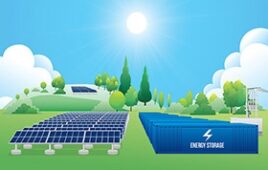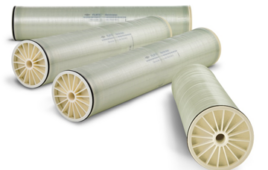A new PNNL study shows that 17 percent of the United States’ imported oil for transportation could be replaced by biofuel made from algae grown in outdoor raceway ponds located in the Gulf Coast, the Southeastern Seaboard, and the Great Lakes. This June 2010 satellite photo shows raceway ponds in southern California. |
High
oil prices and environmental and economic security concerns have
triggered interest in using algae-derived oils as an alternative to
fossil fuels. But growing algae — or any other biofuel source — can
require a lot of water.
However,
a new study shows that being smart about where we grow algae can
drastically reduce how much water is needed for algal biofuel. Growing
algae for biofuel, while being water-wise, could also help meet
congressionally mandated renewable fuel targets by replacing 17 percent
of the nation’s imported oil for transportation, according to a paper
published in the journal Water Resources Research.
Researchers
at the Department of Energy’s Pacific Northwest National Laboratory
found that water use is much less if algae are grown in the U.S. regions
that have the sunniest and most humid climates: the Gulf Coast, the
Southeastern Seaboard and the Great Lakes.
“Algae
has been a hot topic of biofuel discussions recently, but no one has
taken such a detailed look at how much America could make – and how much
water and land it would require — until now,” said Mark Wigmosta, lead
author and a PNNL hydrologist. “This research provides the groundwork
and initial estimates needed to better inform renewable energy
decisions.”
Algal
biofuel can be made by extracting and refining the oils, called lipids,
that algae produce as they grow. Policy makers and researchers are
interested in developing biofuels because they can create fewer overall
greenhouse gas emissions than fossil fuels. And biofuels can be made
here in the United States. In 2009, slightly more than half of the
petroleum consumed by the U.S. was from foreign oil.
Wigmosta
and his co-authors provide the first in-depth assessment of America’s
algal biofuel potential given available land and water. The study also
estimated how much water would need to be replaced due to evaporation
over 30 years. The team analyzed previously published data to determine
how much algae can be grown in open, outdoor ponds of fresh water while
using current technologies. Algae can also be grown in salt water and
covered ponds. But the authors focused on open, freshwater ponds as a
benchmark for this study. Much of today’s commercial algae production is
done in open ponds.
Crunching the numbers
First,
the scientists developed a comprehensive national geographic
information system database that evaluated topography, population, land
use and other information about the contiguous United States. That
database contained information spaced every 100 feet throughout the
U.S., which is a much more detailed view than previous research. This
data allowed them to identify available areas that are better suited for
algae growth, such as those with flat land that isn’t used for farming
and isn’t near cities or environmentally sensitive areas like wetlands
or national parks.
Next,
the researchers gathered 30 years of meteorological information. That
helped them determine the amount of sunlight that algae could
realistically photosynthesize and how warm the ponds would become.
Combined with a mathematical model on how much typical algae could grow
under those specific conditions, the weather data allowed Wigmosta and
team to calculate the amount of algae that could realistically be
produced hourly at each specific site.
Water for oil
The
researchers found that 21 billion gallons of algal oil, equal to the
2022 advanced biofuels goal set out by the Energy Independence and
Security Act, can be produced with American-grown algae. That’s 17
percent of the petroleum that the U.S. imported in 2008 for
transportation fuels, and it could be grown on land roughly the size of
South Carolina. But the authors also found that 350 gallons of water per
gallon of oil — or a quarter of what the country currently uses for
irrigated agriculture — would be needed to produce that much algal
biofuel.
The
study also showed that up to 48 percent of the current transportation
oil imports could be replaced with algae, though that higher production
level would require significantly more water and land. So the authors
focused their research on the U.S. regions that would use less water to
grow algae, those with the nation’s sunniest and most humid climates.
But
the authors also found that algae’s water use isn’t that different from
most other biofuel sources. While considering the gas efficiency of a
standard light-utility vehicle, they estimated growing algae uses
anywhere between 8.6 and 50.2 gallons of water per mile driven on algal
biofuel. In comparison, data from previously published research
indicated that corn ethanol can be made with less water, but showed a
larger usage range: between 0.6 and 61.9 gallons of water per mile
driven. Several factors — including the differing water needs of
specific growing regions and the different assumptions and methods used
by various researchers — cause the estimates to range greatly, they
found.
Because
conventional petroleum gas doesn’t need to be grown like algae or corn,
it doesn’t need as much water. Previously published data indicated
conventional gas uses between about 0.09 and 0.3 gallons of water per
mile.
More to consider
Looking
beyond freshwater, the authors noted algae has several advantages over
other biofuel sources. For example, algae can produce more than 80 times
more oil than corn per hectare a year. And unlike corn and soybeans,
algae aren’t a widespread food source that many people depend on for
nutrition. As carbon dioxide-consuming organisms, algae are considered a
carbon-neutral energy source. Algae can feed off carbon emissions from
power plants, delaying the emissions’ entry into the atmosphere. Algae
also digest nitrogen and phosphorous, which are common water pollutants.
That means algae can also grow in — and clean — municipal waste water.
“Water
is an important consideration when choosing a biofuel source,” Wigmosta
said. “And so are many other factors. Algae could be part of the
solution to the nation’s energy puzzle — if we’re smart about where we
place growth ponds and the technical challenges to achieving
commercial-scale algal biofuel production are met.”
Next
up for Wigmosta and his colleagues is to examine non-freshwater sources
like salt water and waste water. They are also researching greenhouse
ponds for use in colder climates, as well as economic considerations for
algal biofuel production.
The paper describes research funded by DOE’s Office of Energy Efficiency and Renewable Energy.
REFERENCE:
Mark S. Wigmosta, Andre M. Coleman, Richard J. Skaggs, Michael H.
Huesemann, Leonard J. Lane. National Microalgae Biofuel Production
Potential and Resource Demand. Water Resources Research. Published
online April 13, 2011.





